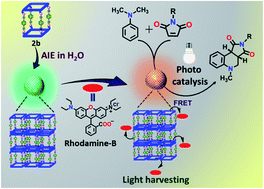Self-assembled metallasupramolecular cages towards light harvesting systems for oxidative cyclization†
Abstract
Designing artificial light harvesting systems with the ability to utilize the output energy for fruitful application in aqueous medium is an intriguing topic for the development of clean and sustainable energy. We report here facile synthesis of three prismatic molecular cages as imminent supramolecular optoelectronic materials via two-component coordination-driven self-assembly of a new tetra-imidazole donor (L) in combination with 180°/120° di-platinum(II) acceptors. Self-assembly of 180° trans-Pt(II) acceptors A1 and A2 with L leads to the formation of cages Pt4L2(1a) and Pt8L2(2a) respectively, while 120°-Pt(II) acceptor A3 with L gives the Pt8L2(3a) metallacage. PF6− analogues (1b, 2b and 3b) of the metallacages possess a high molar extinction coefficient and large Stokes shift. 1b–3b are weakly emissive in dilute solution but showed aggregation induced emission (AIE) in a water/MeCN mixture as well as in the solid state. AIE active 2b and 3b in aqueous (90% water/MeCN mixture) medium act as donors for fabricating artificial light harvesting systems via Förster resonance energy transfer (FRET) with organic dye rhodamine-B (RhB) with high energy efficiency and good antenna effect. The metallacages 2b and 3b represent an interesting platform to fabricate new generation supramolecular aqueous light harvesting systems with high antenna effect. Finally, the harvested energy of the LHSs (2b + RhB) and (3b + RhB) was utilized successfully for efficient visible light induced photo-oxidative cross coupling cyclization of N,N-dimethylaniline (4) with a series of N-alkyl/aryl maleimides (5) in aqueous acetonitrile with dramatic enhancement in yields compared to the reactions with RhB or cages alone.



 Please wait while we load your content...
Please wait while we load your content...